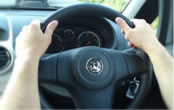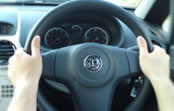The basic push pull steering technique will be demonstrated by your driving instructor during the cockpit drill on your first driving lesson.
Throughout the first few lessons however, don’t be too concerned in keeping a strict steering technique for the car as priorities should be keeping general good control and observation. Your instructor will continually prompt you throughout driving lessons to improve your push pull steering technique if applicable.
For the driving test, although it is essential to maintain a high level of control when steering the car, it is a myth that examiners are looking for a constant and disciplined push pull steering technique throughout the entire driving test.
Providing you keep consistent good control of your car in terms of steering, this is primarily what they are assessing you for. Everybody is a different size and height, have different seating positions using different cars. Certain cars also offer a wide range of options for adjusting the steering wheel and seating positions, whilst others offer a basic minimum. As a result, a drivers hand position on the steering wheel will factor these variations into account.
The process of teaching learner drivers this technique is therefor to provide a safe method that otherwise they would not correctly understand how to use the steering wheel. Feel free to adapt this method to a technique that is more comfortable to you, although keep it similar and try not to cross your hands whilst steering too much.
Steering wheel hand position
There are three recognised methods that are taught to hold the steering wheel. If you imagine the hands on a clock, these positions are known as 10:2 and 9:3. 10:2 is the method traditionally taught by driving instructors, though is now becoming less common in favour of a lower hand placement such as 9:3 which is deemed a more natural and comfortable position.


Those that are taller, using a vehicle with limited steering and seating positions may find that griping the wheel higher in the 10:2 position more comfortable. Many however prefer the relaxed 9:3 position. Essentially, once you have appropriately adjusted the seating and steering position, use which ever steering position you prefer.
Before you start learning to drive, practice these steering ‘push and pull’ techniques using a diner plate. It takes a little time to perfect, but once perfected, it will allow you to concentrate on more important things whilst actually driving such as gears and observation. Hold the steering wheel firmly but also keep it relaxed. Gripping the steering wheel too tightly will become uncomfortable and will make you feel more tense.
Steer left push-pull steering technique
Using either the 10:2 or 9:3 position, grip the wheel with your left hand and loosen your right hand. Pull the wheel using your left hand down to the six o’clock position and slid your right hand down to meet your left.
Now grip with the right hand and loosen the left hand. Push the steering wheel back up with your right hand to the twelve o’clock position, sliding your left hand up to meet the right.
Steer right push-pull steering technique
Again, using either the 10:2 or 9:3 position, grip the wheel with your right hand and loosen your left hand. Pull the wheel using your right hand down to the six o’clock position and slid your left hand down to meet the right.
Grip with your left hand and loosen your right hand. Push the steering wheel back up to the twelve o’clock position with your left hand, sliding the right hand up to meet.
What if I Get the Steering Techniques Wrong During My Test?
A learner starting out for the first time can easily get their hands and arms muddled whilst steering. The above hand positions and steering techniques offer a method to prevent this. The examiner is ultimately looking for good control of the vehicle and not specific hand placements or techniques. Avoid crossing arms to excess, letting the wheel spin freely and keep both hands on the wheel as much as possible. Providing good control is maintained, if you wish feel free to adapt your own steering technique and you’ll do just fine in your test.
Kerbside parking
The driving test will involve the examiner asking that you park up on the left in a legal, safe and convenient position. This will require you parking close to the kerb, ideally within 30 cm. For a learner driver, this can be a challenge.
Use the kerb parking tutorial for the correct procedure and reference points. Whilst parking next to a kerb, use small increments of left steer and straightening the wheel. Keep repeating this, using the reference points until sufficiently close to the kerb. Steering too harshly towards the kerb may result in the front left wheel hitting the kerb.
Steering at different speeds
The slower the car is traveling, the more you will need to steer the wheel. When performing a manoeuvre such as the turn in the road for example, you will need to steer to either full left or right lock as quickly as possible.
When you drive on a fast road such as a dual carriageway at 70 mph however, you will need to steer in tiny increments for a significant effect on the direction of the car. This can surprise a learner driver if they’re not prepared for it.
Driving with one hand
For able bodied drivers, it is a legal requirement that one hand must be kept on the steering wheel at all times whilst the car is moving. If at any point during a driving test you move the car without at least one hand on the steering wheel, the test will be failed
Although legally only one hand must be on the wheel, during a driving test, try and keep both hands on the steering wheel whilst driving forward at all times, other than of course when changing gears or operating auxiliary controls. The driving examiner will see this as safer by keeping better control. Once you have perfected the push-pull steering technique, practice driving with one hand on a quiet road to enable you better control whilst changing gears or operating auxiliary controls.
When reversing however, it is perfectly acceptable during a driving test to use just one hand on the steering wheel. The driving test will involve at least one of the possible four manoeuvres:
All of these manoeuvres require reversing to some degree. For safer observation, it is necessary to turn round in your seat to look out the rear window whilst reversing. In this situation, it can be difficult to keep two hands on the steering wheel. If using one hand, try to keep your hand within the quarter to three position. If your hand strays outside of this area, use two hands.
Spinning the steering wheel
We all develop bad habits after a period of time whilst driving. Allowing the steering wheel to spin on it’s own whilst straightening up (self-centering) is one of them. Try to avoid this during a driving test as it may appear to the examiner that you are not in full control. Feed the steering wheel back round using the push pull technique. Allowing the wheel to spin isn’t necessarily a test failure, although if consistently done, it may amount to more than three driving test minors in the same category and fail you.
Dry Steering
Throughout your time spent learning to drive, you may hear the term ‘dry steering’ being mentioned. This is the term given to the mostly unnecessary act of steering the car whilst stationary. Although this is unlikely to detrimentally affect your driving test, it can affect the condition of your car tyres and steering components. For further information and how to avoid it, see:
Further guides and tutorials
- Cockpit drill
- Mirror adjustment – Setting up the car mirrors
- The blind spot
- How to change gear

thankq so much but i dont know how can i handle steering at car i feel it is tooo difficult
Steering techniques are a guide for novice drivers to offer an ideal method for holding the wheel and for steering the car. The method you use doesn’t have to be exactly the same and in terms of the driving test, providing you have good control of the car, you can use whichever method you like, providing that it is of course safe.